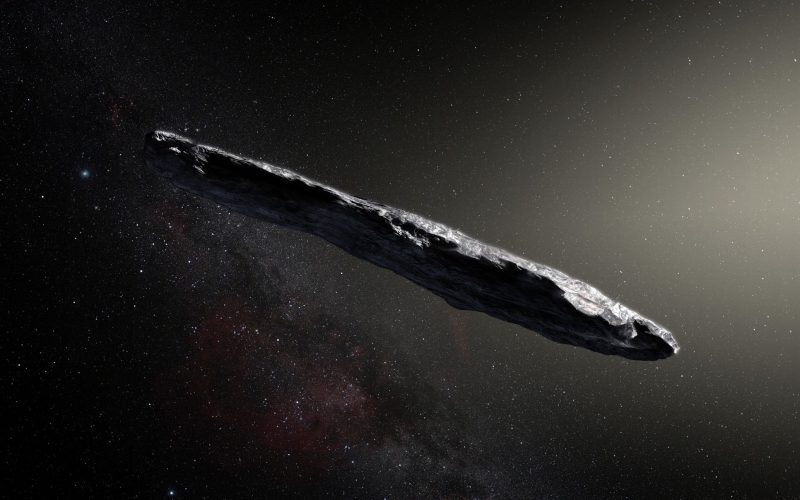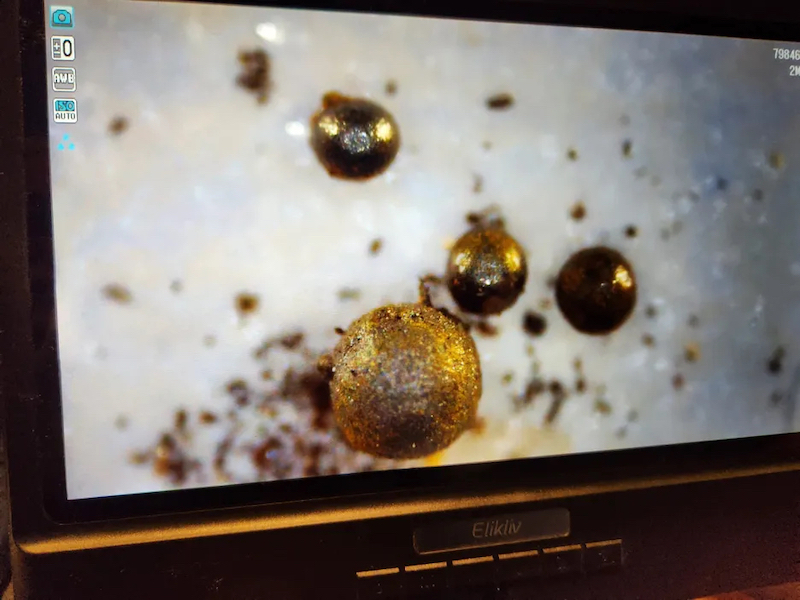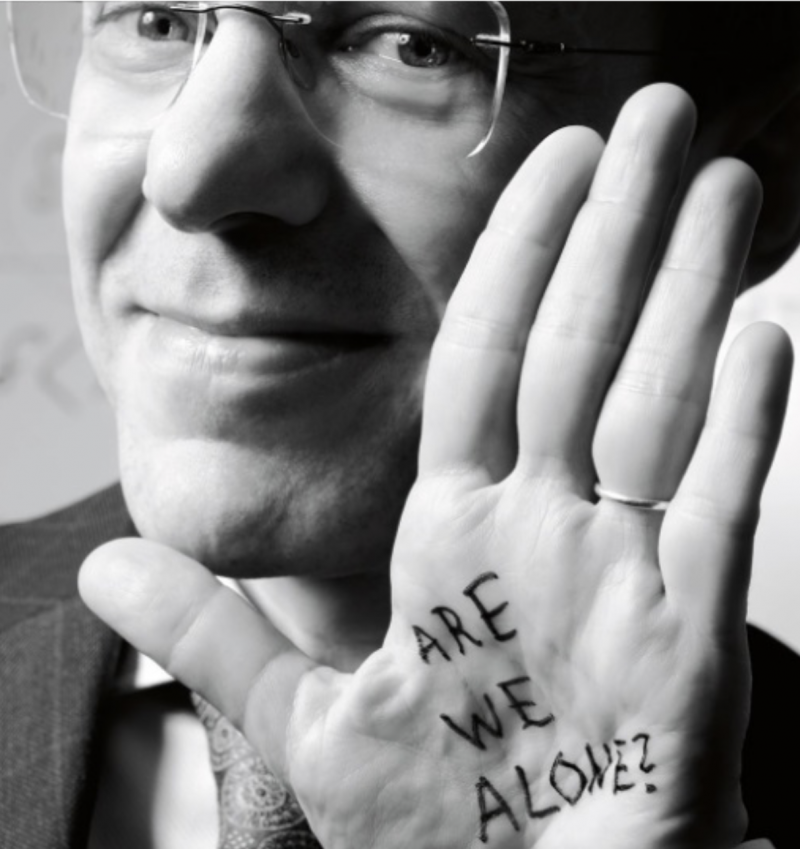
Originally published on July 18, 2023, by Jason Wright. Republished with permission. Edits by EarthSky. Read the original article at AstroWright.
Avi Loeb and alien tech research
As an astrophysicist who searches for signs of alien technology beyond Earth, I’m often asked these days what I think about Avi Loeb.
Loeb, you might know, recently rose to public prominence with his claims that the first discovered interstellar comet, ‘Oumuamua, is actually a piece of an alien spacecraft passing through the solar system. Since then he has headlined UAP conventions, written a very popular book about his claim (now two), and raised millions of dollars to study Unidentified Aerial Phenomena (UAPs, or UFOs) with his Galileo Project initiative. His latest venture with that money is to sweep a metal detector across the Pacific to find fragments of what he claims is another interstellar visitor that the U.S. military detected crashing into the ocean. This resulted in headlines such as Why a Harvard professor thinks he may have found fragments of an alien spacecraft in the Independent.
Not a quack
Loeb has the credentials to be taken seriously. He is a well-respected theoretical cosmologist who has made foundational contributions to our understanding of the early universe. He served as the chair of the Harvard astronomy department, and leads the distinguished Institute for Theory and Computation at the Harvard-Smithsonian Center for Astrophysics. He is well known as an outside-the-box thinker who is brave enough to be wrong often enough to occasionally be right in important and unexpected ways. As well, he is a prolific paper writer, mentor to many students and postdoctoral researchers, and a leader in the community. I, in particular, was strongly influenced by a lecture he gave on diversifying one’s research portfolio to include a lot of safe but passé research, some more risky cutting edge work, and a small amount of outré science. It’s important advice for any scientific field.
But his shenanigans have lately strongly changed the astronomy community’s perceptions of him. His recent claims about alien spacecraft and comets and asteroids largely come across to experts as, at best, terribly naïve, and often as simply erroneous (Loeb has no formal training or previous track record to speak of in planetary science, which has little in common with the plasma physics he is known for). His promotion of his claims in the media is particularly galling to professionals who discover and study comets, who were very excited about the discovery of ‘Oumuamua but have found their careful work dismissed and ridiculed by Loeb, who is the most visible scientist discussing it in the media.
The Pacific discoveries
Most recently, his claims to have discovered possible fragments of an alien ship in the Pacific have been criticized by meteoriticists at a recent conference. Loeb claims the metallic spherules he found trawling the ocean floor are from the impact site of an interstellar object (dubbed 20140108 CNEOS/USG). Critics point out that they are much more likely to have come from ordinary meteorites or even terrestrial volcanoes, or human activities like coal burning ships or WWII warfare in the area. And, they argue, 20140108 most likely did not come from outside the solar system at all. (It also appears that Loeb may have violated legal and ethical norms by removing material from Papua New Guinean waters – you’re not supposed to just go into other countries and collect things without permission.)

Avi Loeb in the media and in the astronomical community
Also frustrating is how Loeb’s book and media interviews paint him as a heroic, transformational figure in science, while career-long experts in the fields he is opining on are characterized as obstinate and short-sighted. His Galileo Project has that name because it is “daring to look through new telescopes.” In his book claiming ‘Oumuamua is an alien spacecraft, he unironically compares himself to the father of telescopic astronomy, Galileo himself. The community was aghast when he blew up at Jill Tarter, a well-respected giant in the field of SETI and one of the best known women in science in the world. (When Tarter expressed annoyance at his dismissal of others’ work in SETI, he angrily accused her of “opposing” him, and of not doing enough for SETI, as if anyone had done more! Loeb later apologized to Tarter and his colleagues, calling his actions “inappropriate.”)
It is true that there is much work to be done to normalize work on SETI and UAPs in scientific circles. Tarter herself has worked for decades to change attitudes about SETI at NASA and among astronomers generally, to get them to embrace the serious, peer-reviewed work to answer one of the biggest questions in science (as I’ve written about before). Scientifically rigorous studies of UAPs have also begun to make inroads, most notably with NASA’s recent panel advising on the topic (Loeb was pointedly not involved; I must note that I see the UAP and SETI questions as scientifically unrelated). But Loeb’s work is unambiguously counterproductive, alienating the community working on these problems and misinforming the public about the state of the field.

A balanced perspective of Avi Loeb
So it is against all of this background that, even when asked, I have generally stayed quiet lately when it comes to Loeb, or tried to give a balanced and nuanced perspective. I do appreciate that he is moving the scientific Overton Window, making SETI, which used to (unfairly) seem like an outlandish corner of science, seem practically mainstream by comparison. I appreciate the support he’s given to my work in SETI, and I generally discourage too much public or indiscriminate criticism of him lest the rest of the field suffer “splash damage.”
I have noticed, however, that Loeb’s work and behavior have been seen as so outrageous in many quarters that it essentially goes unrebutted in popular forums by those who are in the best position to explain what, exactly, is wrong about it. This leaves a vacuum, where the public hears only Loeb’s persuasive and articulate voice, with no obvious public pushback from experts beyond exasperated eye-rolling that feeds right into his hero narrative.
Correcting the record
So for the past several months, I’ve worked with Steve Desch and Sean Raymond, two planetary scientists and experts on ‘Oumuamua, to correct the record. It has taken a lot of time: as Jonathan Swift wrote, “… falsehood flies, and the truth comes limping after it.” I read Loeb’s book on ‘Oumuamua, cover to cover, and carefully noted each of his arguments that ‘Oumuamua is anything other than a comet or asteroid. The three of us then went through and did our best to take an objective look at whether his statement of the evidence is correct, whether it really supports the alien spacecraft hypothesis, and whether it is actually consistent with ‘Oumuamua being a comet. No surprise, we find that under careful scrutiny his claims are often incorrect, and that there is little to no evidence that ‘Oumuamua is an artificial object. We’ve done our best in our rebuttal to avoid criticizing Loeb or his behavior, and to focus instead just on what we do and do not know about ‘Oumuamua. You can find our analysis here.
There is little joy in or reward for debunking claims in science. We would all rather be finding new natural phenomena to celebrate than spending a lot of time correcting the mistakes or false claims of others published years earlier.
A thrilling astronomical future
Because the truth is, we’re entering a new era of astronomy where we can, for the first time, contemplate studying samples from other solar systems, where we are seeing the first serious and comprehensive searches for signs of alien technology among the stars, and where truly new telescopes and methods are unlocking secrets of the universe that will thrill fans of science around the world, all without any need for sensationalism. Now that we’ve addressed Loeb’s most outlandish claims about ‘Oumuamua, I’m excited to get back to work on it!
Bottom line: Astronomer Jason Wright of the blog AstroWright explains why some of Avi Loeb’s recent work is seen as outrageous by some, but also highlights some benefits that have come out of his endeavors.
Read more:
Interstellar, a new book by Avi Loeb
Was ‘Oumuamua a comet? Avi Loeb responds to new research
Sea-going search for alien fragments yields odd spherules
The post Avi Loeb and ‘Oumuamua. Why the controversy? first appeared on EarthSky.
from EarthSky https://ift.tt/Q0CjrSm

Originally published on July 18, 2023, by Jason Wright. Republished with permission. Edits by EarthSky. Read the original article at AstroWright.
Avi Loeb and alien tech research
As an astrophysicist who searches for signs of alien technology beyond Earth, I’m often asked these days what I think about Avi Loeb.
Loeb, you might know, recently rose to public prominence with his claims that the first discovered interstellar comet, ‘Oumuamua, is actually a piece of an alien spacecraft passing through the solar system. Since then he has headlined UAP conventions, written a very popular book about his claim (now two), and raised millions of dollars to study Unidentified Aerial Phenomena (UAPs, or UFOs) with his Galileo Project initiative. His latest venture with that money is to sweep a metal detector across the Pacific to find fragments of what he claims is another interstellar visitor that the U.S. military detected crashing into the ocean. This resulted in headlines such as Why a Harvard professor thinks he may have found fragments of an alien spacecraft in the Independent.
Not a quack
Loeb has the credentials to be taken seriously. He is a well-respected theoretical cosmologist who has made foundational contributions to our understanding of the early universe. He served as the chair of the Harvard astronomy department, and leads the distinguished Institute for Theory and Computation at the Harvard-Smithsonian Center for Astrophysics. He is well known as an outside-the-box thinker who is brave enough to be wrong often enough to occasionally be right in important and unexpected ways. As well, he is a prolific paper writer, mentor to many students and postdoctoral researchers, and a leader in the community. I, in particular, was strongly influenced by a lecture he gave on diversifying one’s research portfolio to include a lot of safe but passé research, some more risky cutting edge work, and a small amount of outré science. It’s important advice for any scientific field.
But his shenanigans have lately strongly changed the astronomy community’s perceptions of him. His recent claims about alien spacecraft and comets and asteroids largely come across to experts as, at best, terribly naïve, and often as simply erroneous (Loeb has no formal training or previous track record to speak of in planetary science, which has little in common with the plasma physics he is known for). His promotion of his claims in the media is particularly galling to professionals who discover and study comets, who were very excited about the discovery of ‘Oumuamua but have found their careful work dismissed and ridiculed by Loeb, who is the most visible scientist discussing it in the media.
The Pacific discoveries
Most recently, his claims to have discovered possible fragments of an alien ship in the Pacific have been criticized by meteoriticists at a recent conference. Loeb claims the metallic spherules he found trawling the ocean floor are from the impact site of an interstellar object (dubbed 20140108 CNEOS/USG). Critics point out that they are much more likely to have come from ordinary meteorites or even terrestrial volcanoes, or human activities like coal burning ships or WWII warfare in the area. And, they argue, 20140108 most likely did not come from outside the solar system at all. (It also appears that Loeb may have violated legal and ethical norms by removing material from Papua New Guinean waters – you’re not supposed to just go into other countries and collect things without permission.)

Avi Loeb in the media and in the astronomical community
Also frustrating is how Loeb’s book and media interviews paint him as a heroic, transformational figure in science, while career-long experts in the fields he is opining on are characterized as obstinate and short-sighted. His Galileo Project has that name because it is “daring to look through new telescopes.” In his book claiming ‘Oumuamua is an alien spacecraft, he unironically compares himself to the father of telescopic astronomy, Galileo himself. The community was aghast when he blew up at Jill Tarter, a well-respected giant in the field of SETI and one of the best known women in science in the world. (When Tarter expressed annoyance at his dismissal of others’ work in SETI, he angrily accused her of “opposing” him, and of not doing enough for SETI, as if anyone had done more! Loeb later apologized to Tarter and his colleagues, calling his actions “inappropriate.”)
It is true that there is much work to be done to normalize work on SETI and UAPs in scientific circles. Tarter herself has worked for decades to change attitudes about SETI at NASA and among astronomers generally, to get them to embrace the serious, peer-reviewed work to answer one of the biggest questions in science (as I’ve written about before). Scientifically rigorous studies of UAPs have also begun to make inroads, most notably with NASA’s recent panel advising on the topic (Loeb was pointedly not involved; I must note that I see the UAP and SETI questions as scientifically unrelated). But Loeb’s work is unambiguously counterproductive, alienating the community working on these problems and misinforming the public about the state of the field.

A balanced perspective of Avi Loeb
So it is against all of this background that, even when asked, I have generally stayed quiet lately when it comes to Loeb, or tried to give a balanced and nuanced perspective. I do appreciate that he is moving the scientific Overton Window, making SETI, which used to (unfairly) seem like an outlandish corner of science, seem practically mainstream by comparison. I appreciate the support he’s given to my work in SETI, and I generally discourage too much public or indiscriminate criticism of him lest the rest of the field suffer “splash damage.”
I have noticed, however, that Loeb’s work and behavior have been seen as so outrageous in many quarters that it essentially goes unrebutted in popular forums by those who are in the best position to explain what, exactly, is wrong about it. This leaves a vacuum, where the public hears only Loeb’s persuasive and articulate voice, with no obvious public pushback from experts beyond exasperated eye-rolling that feeds right into his hero narrative.
Correcting the record
So for the past several months, I’ve worked with Steve Desch and Sean Raymond, two planetary scientists and experts on ‘Oumuamua, to correct the record. It has taken a lot of time: as Jonathan Swift wrote, “… falsehood flies, and the truth comes limping after it.” I read Loeb’s book on ‘Oumuamua, cover to cover, and carefully noted each of his arguments that ‘Oumuamua is anything other than a comet or asteroid. The three of us then went through and did our best to take an objective look at whether his statement of the evidence is correct, whether it really supports the alien spacecraft hypothesis, and whether it is actually consistent with ‘Oumuamua being a comet. No surprise, we find that under careful scrutiny his claims are often incorrect, and that there is little to no evidence that ‘Oumuamua is an artificial object. We’ve done our best in our rebuttal to avoid criticizing Loeb or his behavior, and to focus instead just on what we do and do not know about ‘Oumuamua. You can find our analysis here.
There is little joy in or reward for debunking claims in science. We would all rather be finding new natural phenomena to celebrate than spending a lot of time correcting the mistakes or false claims of others published years earlier.
A thrilling astronomical future
Because the truth is, we’re entering a new era of astronomy where we can, for the first time, contemplate studying samples from other solar systems, where we are seeing the first serious and comprehensive searches for signs of alien technology among the stars, and where truly new telescopes and methods are unlocking secrets of the universe that will thrill fans of science around the world, all without any need for sensationalism. Now that we’ve addressed Loeb’s most outlandish claims about ‘Oumuamua, I’m excited to get back to work on it!
Bottom line: Astronomer Jason Wright of the blog AstroWright explains why some of Avi Loeb’s recent work is seen as outrageous by some, but also highlights some benefits that have come out of his endeavors.
Read more:
Interstellar, a new book by Avi Loeb
Was ‘Oumuamua a comet? Avi Loeb responds to new research
Sea-going search for alien fragments yields odd spherules
The post Avi Loeb and ‘Oumuamua. Why the controversy? first appeared on EarthSky.
from EarthSky https://ift.tt/Q0CjrSm

Aucun commentaire:
Enregistrer un commentaire